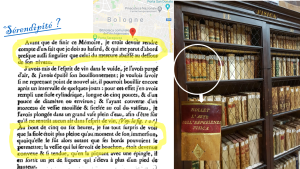Filtration and osmotic pressure
Conseil : And if we filter something other than pure water!
With your expert filtrometer patent in your pocket, you know how to describe filtration and permeability through a membrane when filtering pure water! That's a good start, but now we need to see what happens when we filter a solution or dispersion containing species that will be retained by the membrane. Depending on the membrane used, these may be soluble molecules (ions, molecules such as sugars, macromolecules such as proteins) or insoluble particles (such as clay). For all sub-micrometre species known as colloids, it's important to consider the phenomenon of osmosis and how it modifies the filtration equation you know.
\(J=\frac{L_p}{\mu}PTM=\frac{PTM}{\mu R_m}\)
Feel free to review the previous level if you've forgotten!
L'osmose : qu'est ce que c'est ?
We'll have to dig through some old manuscripts to get back to the discovery of osmosis. The first traces of it can be found in the books of Abbé Nollet, circa 1750, who reports an astonishing experiment with a pig's bladder!
This experience reminds us what is sérendipity in scientific research, as he reports the experience in these words "je crois devoir rendre compte d'un fait que je dois au hasard, & qui me parut d'abord presque aussi singulier ..." "I believe I must give an account of a fact which I owe to chance, & which at first seemed to me almost as singular. ...".
He then recounts his experiment with a pig's bladder and the osmosis that led to filling a flask and inflating the bladder "which had become convex and so taut, that on pricking it with a pin, a jet of liquor came out and rose to a height of more than a foot". But here's a sequence to explain the experiment and how it came to be explained over the centuries that followed!
Simulation : Comment prendre de compte l'osmose dans la loi de filtration ?
This osmosis phenomenon will modify the flow in the membrane: an osmotic flow from the filtrate to the retentate will reduce permeation.
\(J=\frac{PTM-\Delta\Pi}{\mu R_m}\)
This is explained in the next slide.
We will therefore have to consider the modified filtration law by integrating osmotic back pressure later on.
Fondamental :
How do you calculate osmotic pressure?
It is therefore important to be able to calculate osmotic pressure for dispersions and solutions. Here you'll find Van't Hoff's law for calculating osmotic pressure as a first approximation (for an ideal dispersion).
Conseil :
You can now test yourself in the downhill runs on the green "solution" track, where you'll have to calculate osmotic pressures, and then the "counter-pressure" track, where you'll have to calculate permeation for a given osmotic counter-pressure. If you answer correctly, you should have your first osmotic flake!
